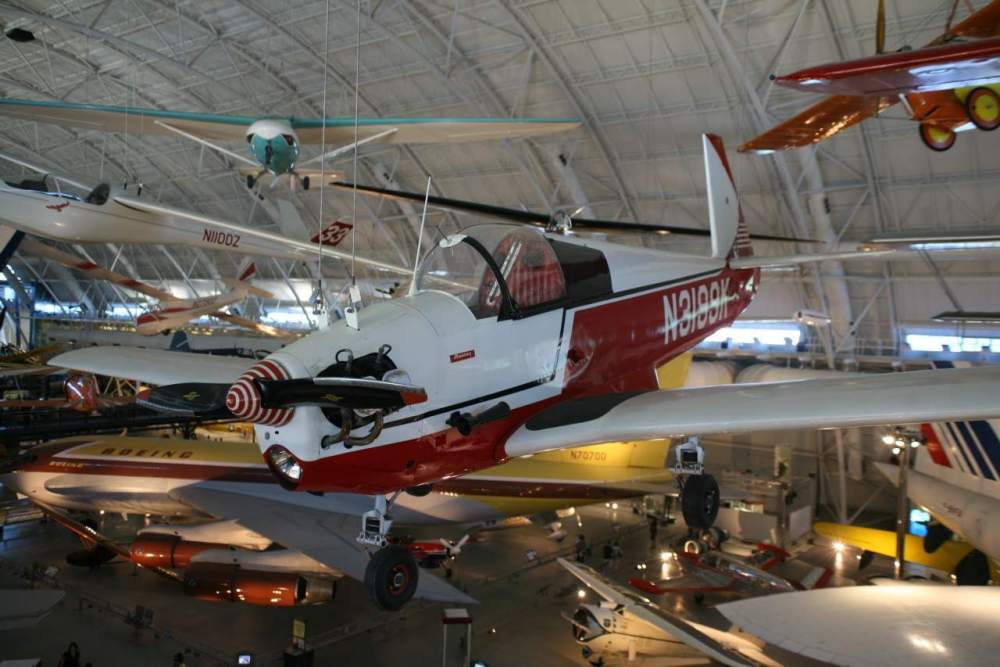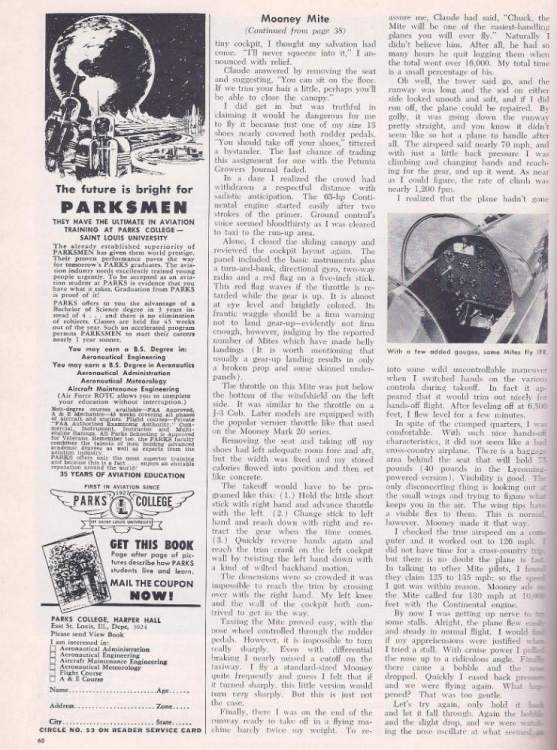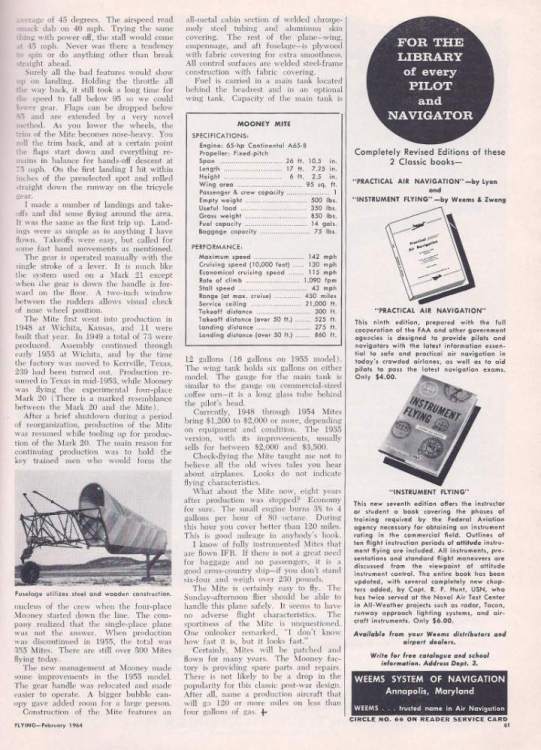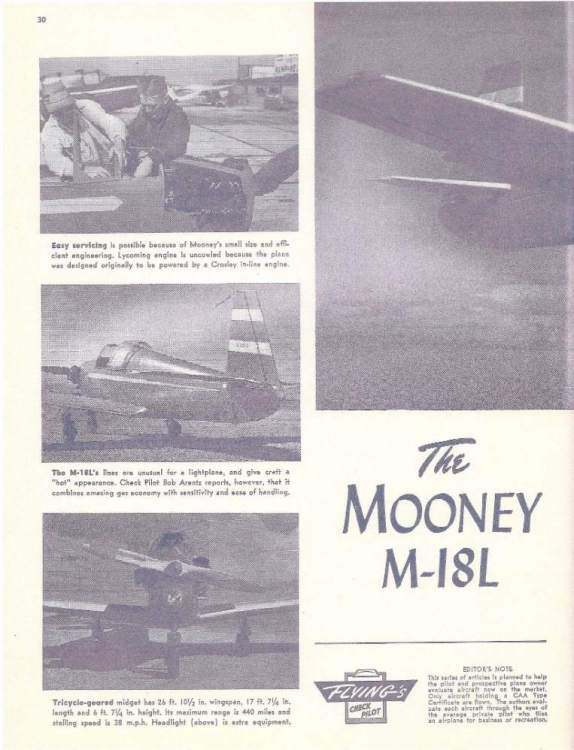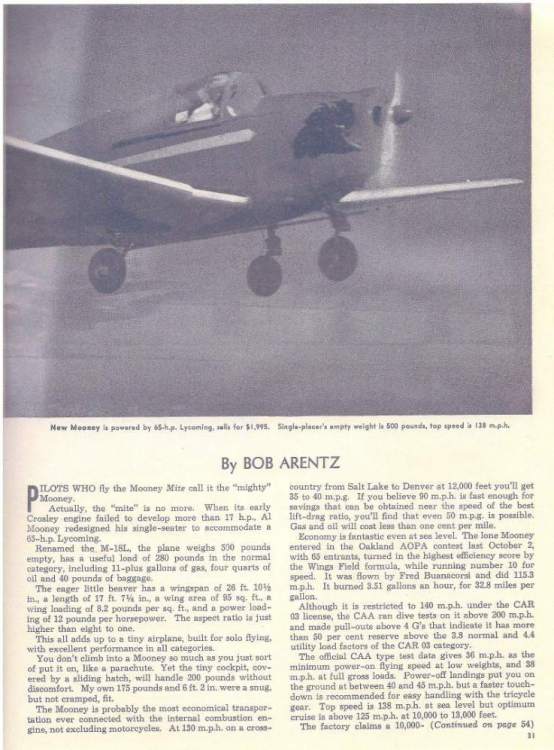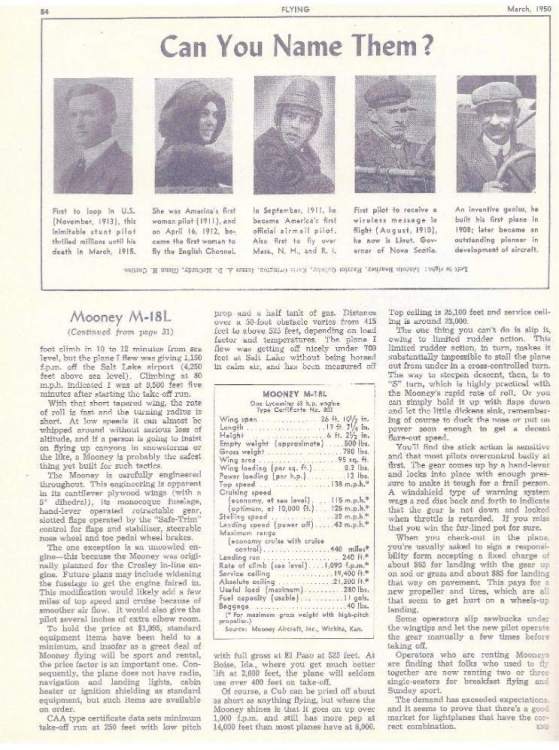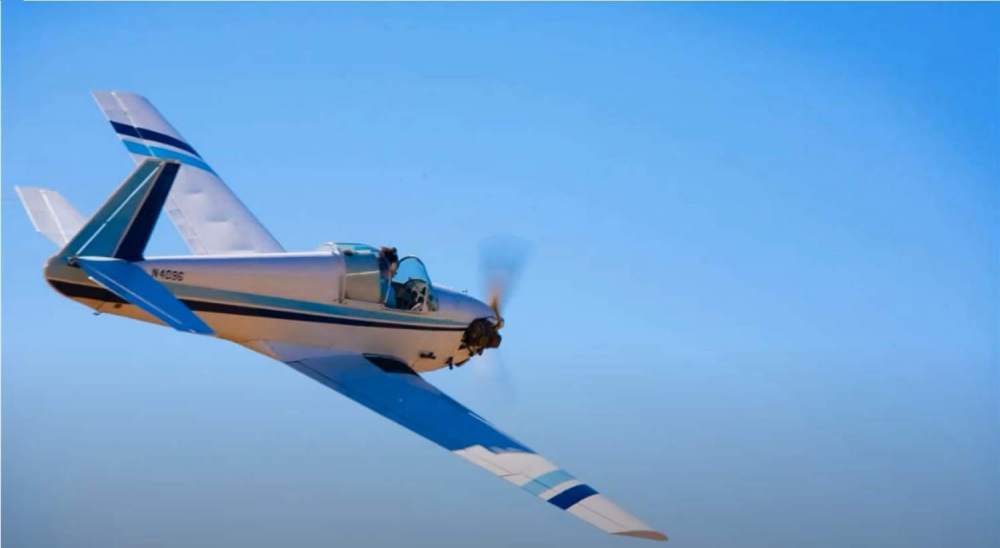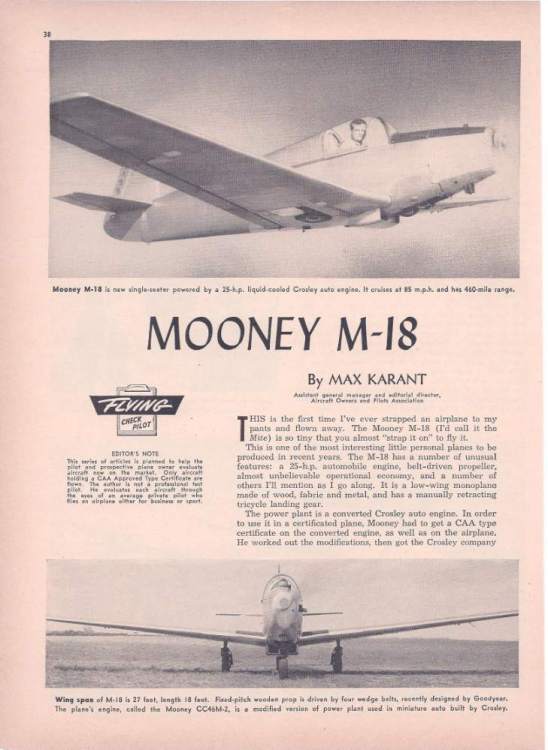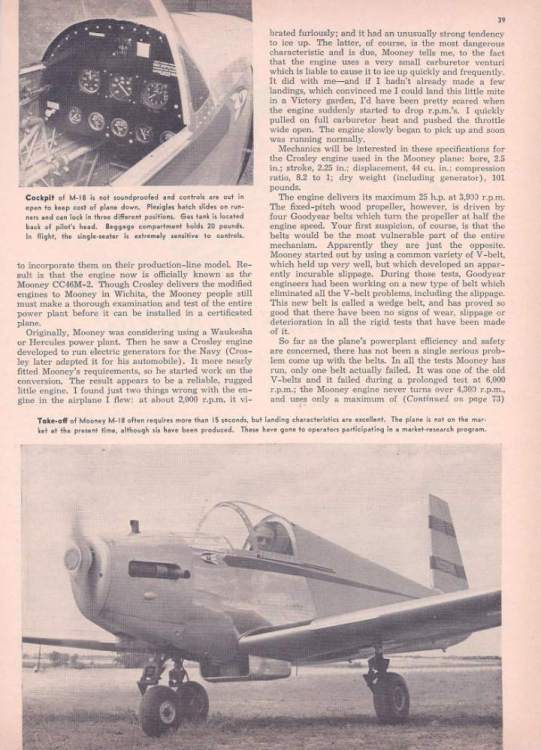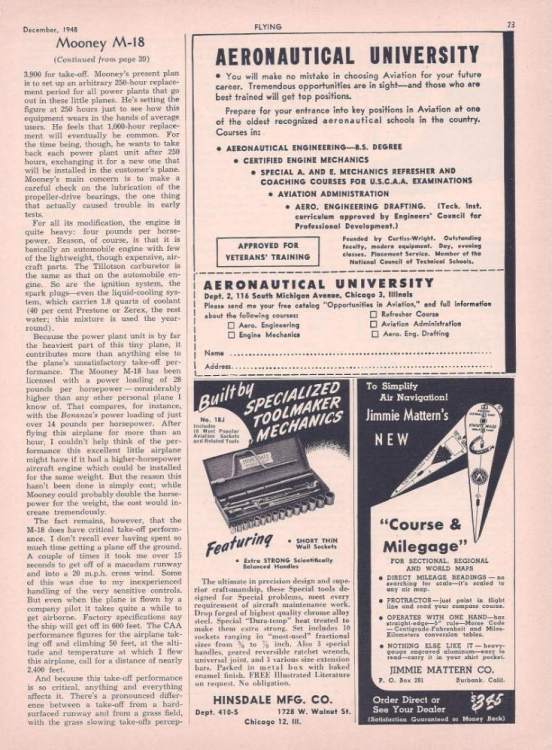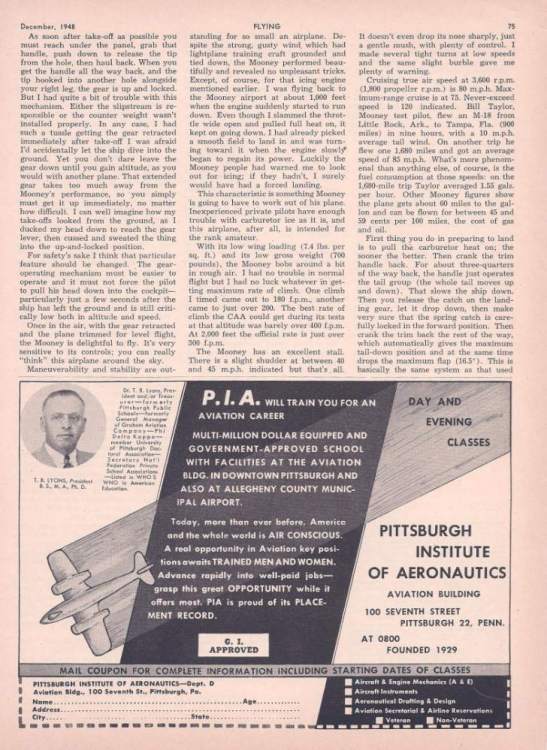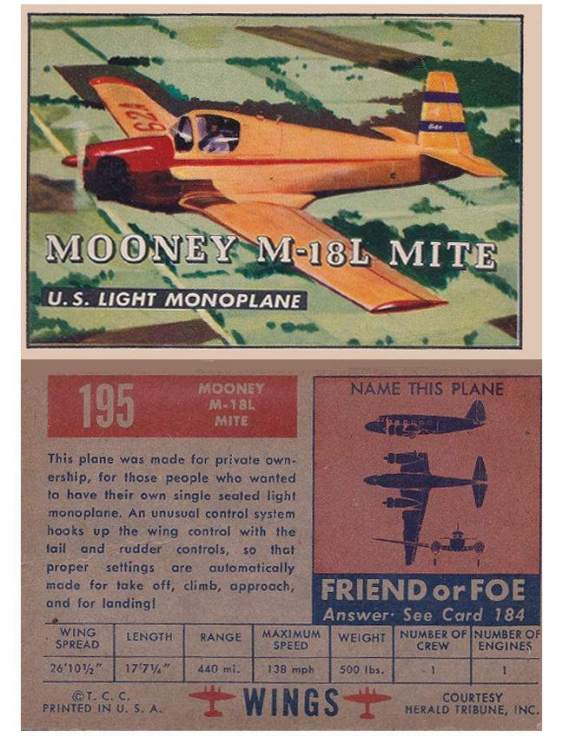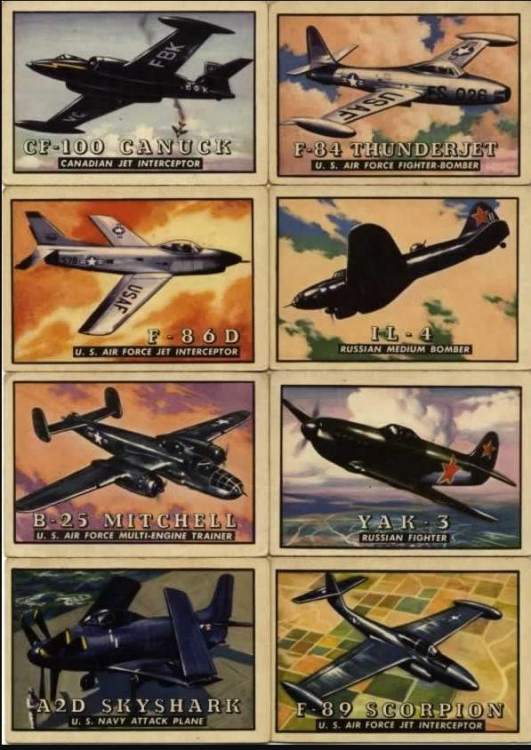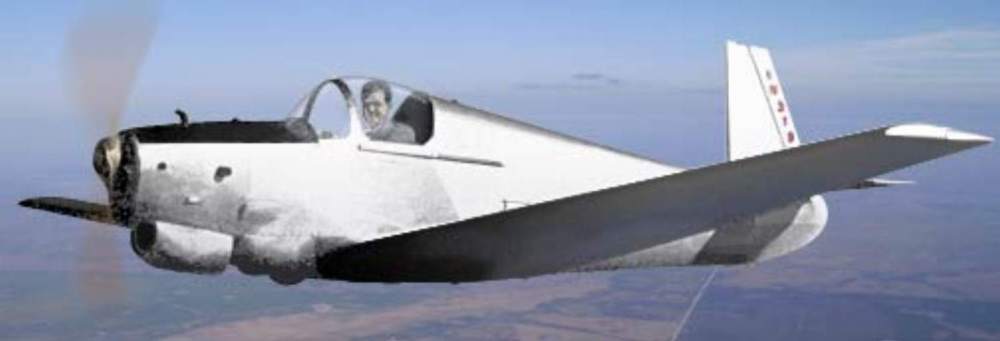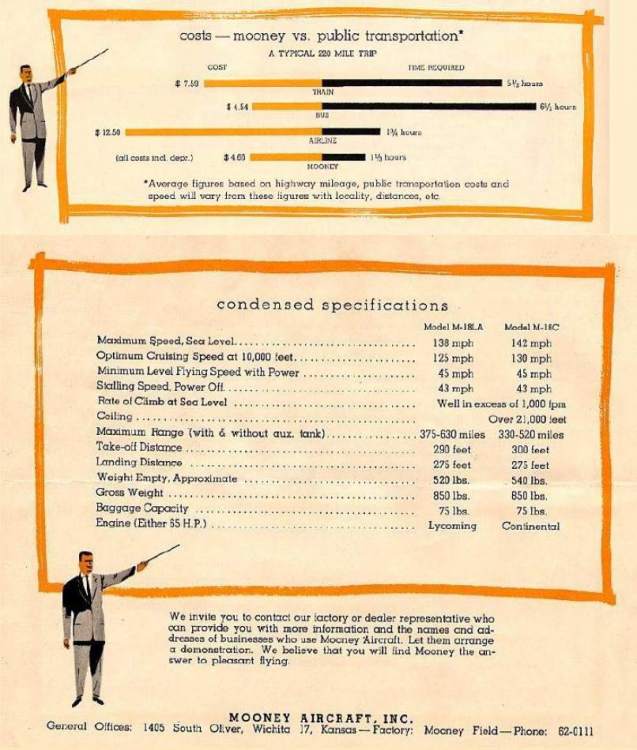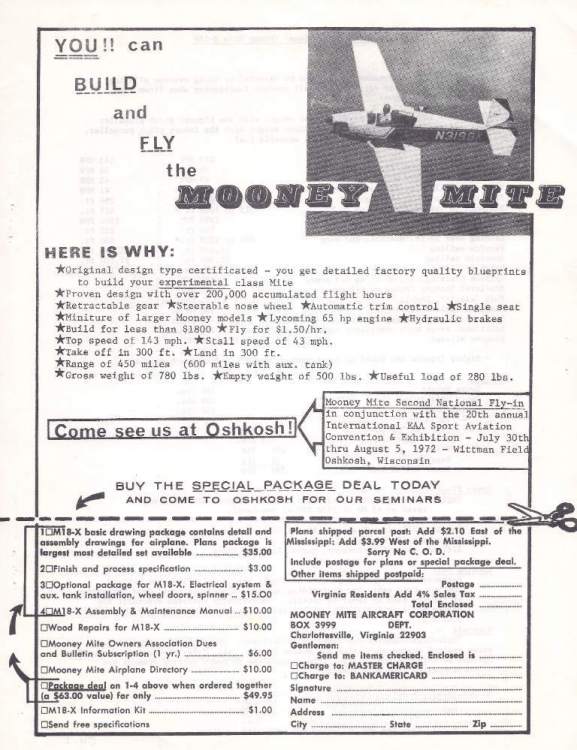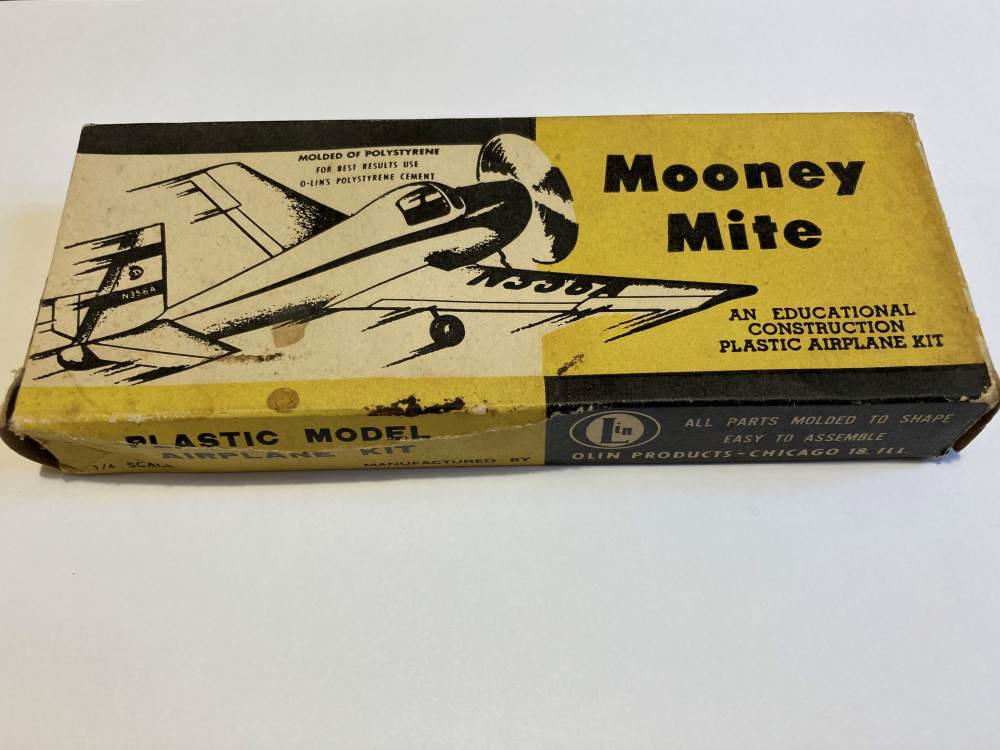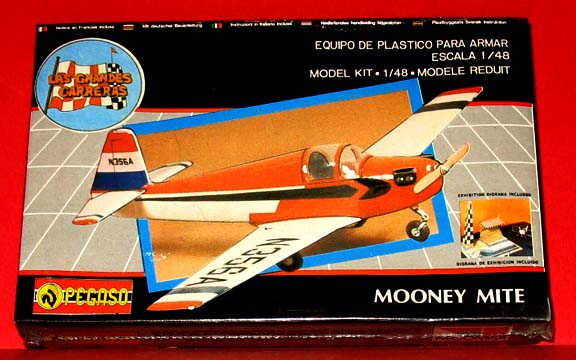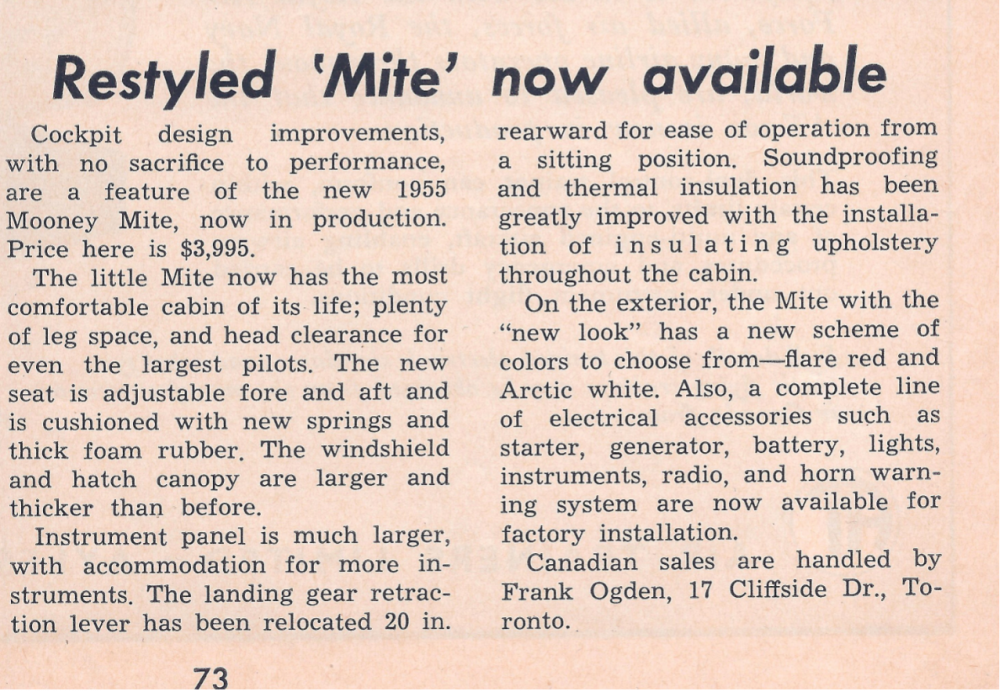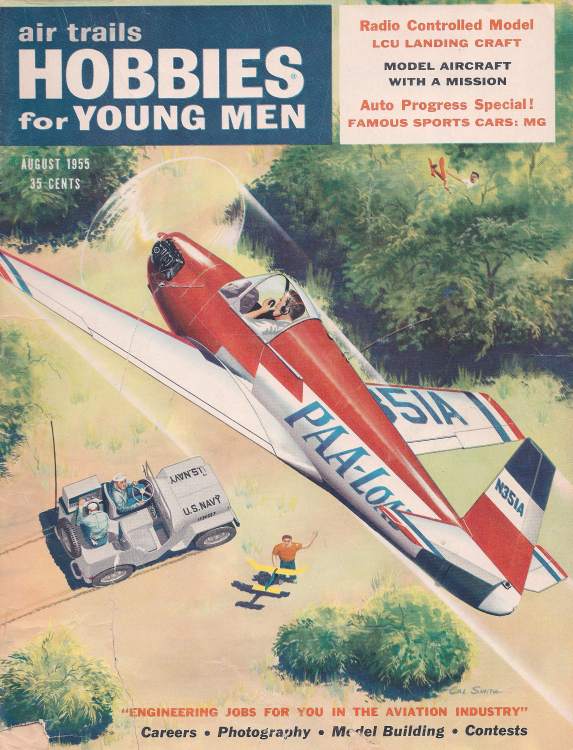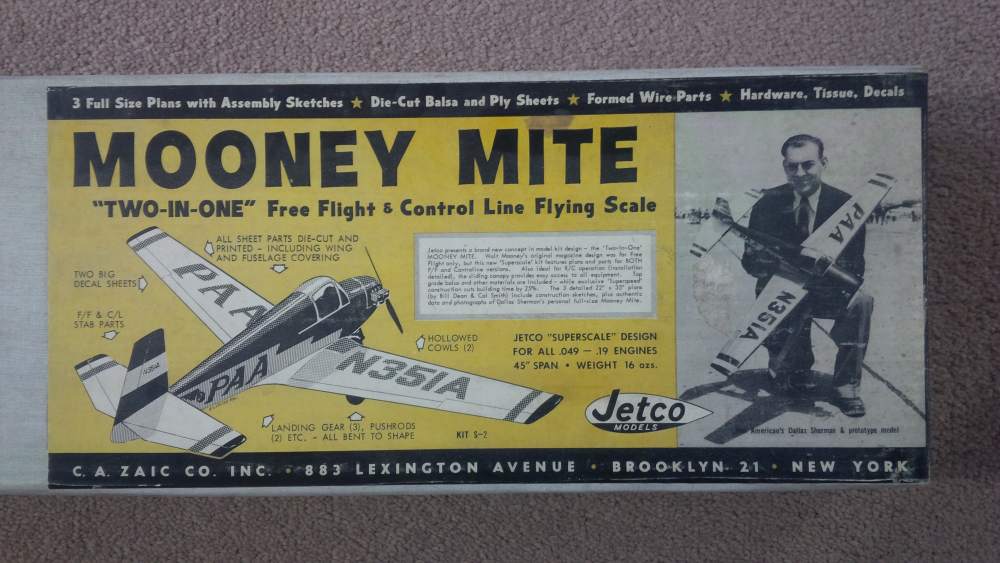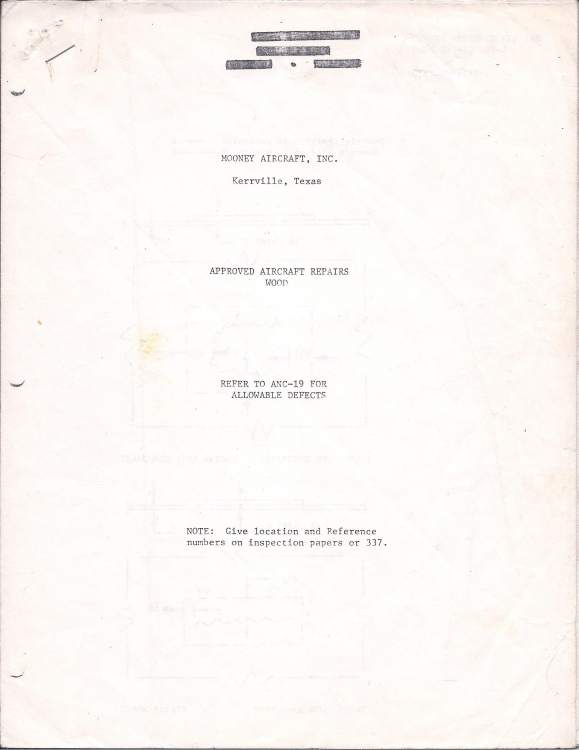-
Posts
112 -
Joined
-
Last visited
Content Type
Profiles
Forums
Blogs
Gallery
Downloads
Events
Store
Everything posted by Kevin Harberg
-
Missing Serial Numbers? As a result of reading Dave Rutherford's (Founder of "The Mite Site") collection of "Mooney M-18" Registered and Historical Registration information, I had discovered issuance of serial Number 001 as well as the highest serial number issued, #357. One would assume 357 Mites were built during the initial run of M-18 models right up until M-18 C55 (1955) model. Ser No.001 - 082 Model M-L (Lycoming 0145 780lbs Gross Wt) 82 Ser. No. 101 - 145 Model M-18LA (Lycoming 0145 850lbs Gross Wt) 45 Ser No. 201 - 357 Model M-18C (Contiental A65 850lbs Gross Wt) 157 This demonstrates that at the end of the production run of one model, the Serial Numbers jumped to start at the next "100" to differentiate between models. The exception seems to be the introduction of the M-18C55 model that appears to continue on with the M-18C numbering. The 18 "Missing Serial Numbers between Serial Number 083 to 100 plus the 55 "Missing Serial Numbers between Serial Number 146 to 200 account for 73 missing serial numbers of aircraft never built. So there were 284 Mites built? No! Actually there were potentially 283 Mites built. (serial No. 1 was rebuilt by Mooney and re-issued as Serial Number 201 (This is the one "Hanging" in the Smithsonian). Serial Numbers now officially start at 002). But wait . . . an article in the Mite Site still shows 47 missing FAA registrations and has identified those serial numbers unaccounted for. 236 Mites?
-
The volume of prints for the M-18X far exceeds the volume of prints included in homebuilder plans of the era (The M-18X prints are actually reprints of the M-18 production model). Your price may seem fair to those who would like a set. What would be the overall weight and volume required for shipping? Have you located any of the additional documents offered for sale with the prints (Assembly manuals, gear/aux tank drawings etc)? Thanks for saving the prints and offering them to the Mooney community. PS: these prints may also be of use by those restoring certified M18's. Only 283 were built and many are in storage awaiting rebuild. That explains why the prints were often sold with a Mooney Mite wood repair manual. Less than 5 M-18X aircraft built to date. Unknown quantity of prints sold.
-
The Mooney Mite Owners Forum in Mooney Space has posts relating to prints for the M-18X. May be a resource for specific viewership if you reposted there. There came a time when aviation related litigation altered the course of well intended businesses, many concerned about potential liability and the increasing costs to insure for protection. It was believed that the M-18X plans were removed from public availability for such reasons. A fair number of sets are likely still out there (I turned down the opportunity to have my own slightly used set of prints for free, a decision I sometimes regret). The price new was quite affordable at the time of print, and I would suspect there may be only a small number of immediate potential purchasers of plans for the M-18X, therefore I would expect any plans available for sale would be priced modestly. A list of plans, other drawings, and manuals available with the set of prints is shown in an ad in the aforementioned site. PS: I believe prints are now available for viewing at the Smithsonian. Regards, Kevin Harberg C-GXTR M-18X
-
Found this beauty somewhere on the internet a while ago. N4096 NOW THAT JUST DOESN'T LOOK LIKE ANY FUN AT ALL!
-
FLYING Magazine Dec 1948 Al Mooney only marketed the plane as the "M-18/M-18L/M-18LA/M-18C/M-18 C55" other than the 1953 models that were marketed as the "Wee Scotsman" to promote the aircraft's low operating costs. "MITE" was a nickname used by Max Karant submitting a pilot report for Dec. 1948 Flying Magazine. The name stuck right up until it became official on Jan 28, 1999 (US DOT N 7110.183). A very popular spray plane with the M-18 designator replaced the Mooney M-18 designation and the M-18 officially became designated "Mooney Mite" as far as the US Department of Transportation FAA, ICAO, NAV CANADA and Eurocontrol are concerned. Note: FOR OPTIMAL VIEWING CLARITY . . "CLICK" ON PICTURE THEN "CLICK" TO ZOOM FULL ARTICLE ON THIS SITE - M18 PILOT REPORT DECEMBER 1948 "FLYING MAGAZINE"
-
Looked for a Mickey Mantle in the drawer with no luck, but turned up what appears to be another TOPPS Trading Card. This is the TOPPS JETS SERIES. "Mite" is in quotation marks because Al Mooney only marketed the plane as the "M-18L/LA/C/C55" other than the 1953 models that were marketed as the "Wee Scotsman" to promote the aircraft's low operating costs. "MITE" was a nickname used by an airplane magazine contributor submitting a flight review. The name stuck right up until it became official on Jan 28, 1999 (US DOT N 7110.183). A very popular spray plane with the M-18 designator replaced the Mooney M-18 designation and the M-18 officially became designated "Mooney Mite" as far as the US Department of Transportation FAA, ICAO, NAV CANADA and Eurocontrol are concerned.
-
"FRIEND OR FOE" Early 1950's Topps Trading Cards (200 Total Set). This set of trading cards had a painted depiction of an airplane (based on aircraft photographs provided by New York Herald Tribune) on one side and a "Friend or Foe" Quiz" on the opposite side, Condensed specifications were also included on the opposite side. This card is of the lighter weight Lycoming powered M-18L model. (Later M-18C models were Continental A65 powered with 850lbs gross weight and max cruise of 143mph).
-
Seems like checklists provide our only reliable safety net, however it relies on us aviators to remember to initiate and perform the checklist. Al Mooney increased gear position awareness (after his gear up landing in the M-18) through the introduction of the Wig Wag device. In addition, 1953 and later M-18 models had a round window covered in plexiglass on the nose wheel "bump". If the Wig Wag didn't catch your attention, you were supposed to look between your legs to visually check actual gear position visible through the window on the nose wheel well. None of it works without performing the task. "G_U_M_P" also works great if you remember to do it! The best I have seen is the toggle switch checklist now sold by Missionary Bush Pilot. This device mounts on top of the dash with Velcro, and allows you to toggle "UP" through the checklist as you complete pre-takeoff to cruise phases of checks, and toggle "DOWN" as you complete each pre-landing check. He will make custom units for all makes and models of aircraft. It is difficult to forget to perform your checklists when you can't avoid seeing the unit when looking out the windshield. Alas, the Mooney Mite didn't come with a dash to mount one on. G_U_M_P ! ! ! NB: You can see this device in use by viewing "Missionary Bush Pilot" videos on YouTube. Ryan (the host), pilots a Kodiak through the remotely settled regions of Papua New Guinea. Great scenery and a good source of watching cockpit management skills in action.
-
The above brochure shows the 1st production M-18 model (which used the Crosley automobile engine and a 3 belt drive reduction unit). This M-18 had the P-51 style belly mounted radiator. The take-off and climb performance was marginal and the M-18 suffered from powerplant reliability using the auto engine conversion. Although eleven of these were sent to aircraft distributors across the United States, all were returned to Mooney to receive the Lycoming 0-145 upgrade (more than doubling the little single place airplane's horsepower). Altitude, range, and speed records for production aircraft of this weight class were achieved as a result of this upgrade. This was the start of Mooney's attention grabbing fame. Speed records continue to fall with the Mooney M-20 aircraft based on this design. Shown below is the M-18 prototype. (It used a 4 belt drive reduction unit and had a forward mounted radiator).
-
-
Still not fast enough? With Mooney's clean lines, all that's required to boost cruise numbers appears to be horsepower. Consider the Mooney Mite's performance with 85-90Hp. 85Hp M-18's are reported to have economy cruise speeds of 145mph while the 90Hp M-19 was reported to cruise at 150mph. Not bad for a 1946 design! Not the 2mph per horsepower (@75% and optimum altitude) of the 65Hp models but quite impressive just the same.
-
Actually, when Al Mooney sold "Mooney", the new owners of the company purchased "Mooney" conditionally upon the inclusion of a 4 place aircraft design based on the M-18. After the start of the M20 production, "Mooney" stopped production of the M18. After many years with no Mooney single seat aircraft being made, The Mooney Mite Aircraft Corporation bought the plans from the owners of "Mooney" with the intent of making the plane available again via the Experimental market. These plans are now in the hands of the Smithsonian. PS. If you hover over my thumbnail photo, you will see the aircraft in the left bank is not an M20. They are so similar that with the Faux window on the M-18X, you will only differentiate between airborne models by the sound of the engine.
-
Here's one listing of plans/prints/manuals etc. for the Experimental Mooney M-18X that was available in the early 1970's. This ad was inserted in the Mooney Mites Owner's Association quarterly bulletin (April - July 1972). Mooney Mite Aircraft Corporation sold copies of original drawings of the Certified Mooney M-18. These drawings are of the Lycoming 0145 Powered M-18L (780lbs Gr Wt)
-
I also have the "F" model Continental. Gives you the option of a variable pitch propeller with the "flanged" shaft. Just a note regarding the Lycoming 0-145 models in the Mooney M18, I believe they were a bed-mount installation. I might be wrong, but heard it from a reliable "Mooniac". Regards, Kevin
-
Sorry for the delay in replying to this post (notification setting issues - my bad). This manual was from Mooney Mite Aircraft Corporation 1970. It contains information relevant to the Mooney M18 (the owner of the company purchased the M-18 design and made the aircraft available to the public as a homebuilt design). I have a copy but no longer have the full set of prints. I believe copies are still available on the "Mite Site". Regards, Kevin
-
This Mooney Mite O-lin Products Model Kit No 300 references "Plastic" model molded from polystyrene. (Post Bakelite era). Puts into perspective the era in which the Mooney aircraft was designed. Its 1946 design predates plastic!
-
-
1955 was the proposed debut year for the Mooney M20. The 1955 M18-C55 (offered during production changes to the assembly line), included several modifications incorporated in the M19 Model with the exception of the larger 90hp engine and enclosed cowling, and of course the two 30 calibre machine guns (one in each wing).
-
- 1
-

-
August 1955 Air Trails Hobbies for Young Men Only 283 Mooney M18's built but generated enough interest to produce many items of memorabilia. This is one of the flying models produced.
-
Hello Scott, You may also want the 48 page assembly manual along with the prints. It includes drawings and parts number listings.
-
Hello Scott, Do you still have the original -55 wing that you load tested to incredible G's? I still have a second Mite but it doesn't have the wing anymore (trampled by cattle when stored at Denver Jacobson's brother's farm).
-
Make sure you reference Mooney's "Approved Aircraft Repairs - Wood" as per attached sample. Pg 23 of 24 included here as example of manual.


